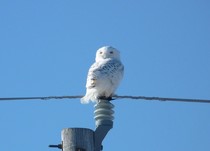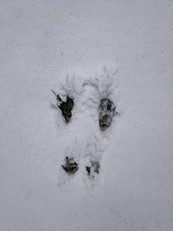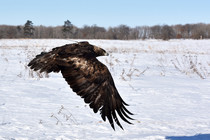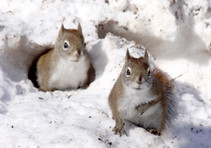|
December 2022
When the weather gets cold, humans turn the heat on and hygge up. But Minnesota’s wildlife take a different approach.
Taking it easy
Some wildlife species survive winter by slowing down. Bats will go into torpor and essentially sleep the season away. Caterpillars (pictured) will curl up in a pile of dead leaves and slow down their metabolism, staying put until the weather gets warmer. Turtles take in oxygen from water, so when the temperatures drop they begin a process called anaerobic respiration, which lets them survive on the lower oxygen levels present in cold water.
|
|
 |
Changing colors
We aren’t the only ones who break out winter coats! White-tailed deer will grow a thicker, darker pelt to protect themselves from the cold. Other mammals, such as snowshoe hares and short-tailed weasels, will grow a white coat to blend in with the snow and camouflage from predators. Some bird species, like the goldfinch even change plumage during winter months. Others, like grouse and prairie chickens, will grow feathers on their feet.
Freezing
Yes, you read that right! Some amphibians survive Minnesota’s icy cold by “freezing”. As temperatures drop, wood frogs will produce an antifreeze that keeps the liquid inside their cells from forming ice crystals. The frogs stop breathing and their heart stops beating. When the weather warms up, the frogs thaw out and begin their spring calls.
Staying active
While some species go to extremes to survive, others continue with business as usual. Many wildlife species, such as squirrels, owls, and mudpuppies (pictured), stay active in the winter months. The fallen leaves make it easier to spot critters in the trees, so winter is a great time to get out and look for wildlife!
|
|
 |

Minnesota is south of somewhere! Snowy owls have begun arriving in Minnesota.
During the summer, snowy owls nest in the arctic tundra of northern Canada and Alaska. From early November to late March, some migrate south to Minnesota to hunt voles, mice, and other small animals. Look for them in large, open areas such as fields and airports.
Learn more about snowy owls at mndnr.gov/birds/snowyowl.html
Snowy owl photo by USFWS
|

When the snow falls and the days grow dark, it can be tempting to curl up at home and wait for spring. But there’s still plenty to do and see in winter, even in your own backyard!
-Start a birdfeeder: Not all birds migrate south for the winter. Some species, like Black-capped chickadees and Northern cardinals, stick around. Set up a bird feeder and record what species stop by. You can even submit your findings to eBird or Project FeederWatch and join a large community of winter birders!
-Look for tracks: Snow provides a great opportunity to see what’s tromping around in your backyard. Three Rivers Park District has a great guide to common animal tracks.
-Explore: The Minnesota Master Naturalist Program has a fun winter nature journal full of activity ideas and information. The booklet was designed for elementary students, but we think it’s great for all ages!
Visit our website for more Nature Out Your Door fun.
|

Winter is one of the only times you might notice golden eagles in Minnesota.
These golden eagles have migrated south from Canada, some from as far north as the Arctic Circle. They spend their winter hunting turkeys and fox squirrels in central and southeast Minnesota. Golden eagles can be hard to distinguish from young bald eagles, but there are subtle differences.
Learn how the Nongame Wildlife Program teamed up with Audubon Minnesota and the National Eagle Center to track golden eagles at mndnr.gov/eco/nongame/projects/golden_eagle_tracking.html
|
|
Growing a thicker pelt is one way Minnesota mammals survive winter. But did you know their fur does more than just keep them warm?
Check out Chris Niskanen’s article “Fantastic Fur” in the Minnesota Conservation Volunteer to learn more.
|
|
 |
|